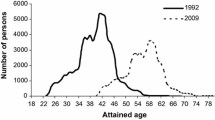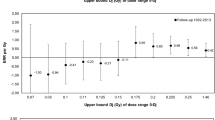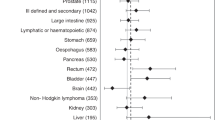Abstract
An analysis is presented of solid cancer incidence during 11 years of follow-up (1991–2001) of Chernobyl emergency workers residing in Russia. The analysis is based on data from the cohort of male emergency workers from 6 regions in Russia including 55,718 persons with documented external radiation doses in the range of 0.001–0.3 Gy who worked within the 30 -km zone in 1986–1987. The mean age at exposure for these persons was 34.8 years and the mean external radiation dose 0.13 Gy. In the cohort 1,370 cases of solid cancer were diagnosed and 3 follow-up periods were considered: 1991–1995, 1996–2001 and 1991–2001. The second follow-up period was chosen to allow for a minimum latency period of 10 years being characteristic of solid cancers. For risk assessment two control groups have been introduced, the first ‘external’ one representing incidence rates for corresponding ages in Russia in general, the second ‘internal’ one consisting of emergency workers. The risk estimates were based on spontaneous incidence rates of solid cancer. The estimated standardized incidence ratio (SIR) is in good agreement (95% CI) with that of the control. The values of excess relative risk per unit dose (ERR/Gy) for solid malignant neoplasms have been estimated to be 0.33 (95% CI: −0.39, 1.22) (internal control) for the follow-up period 1991–2001 and 0.19 (95% CI: −0.66, 1.27) for 1996–2001.


Similar content being viewed by others
References
Thompson DE, Mabuchi K, Ron E et al. (1994) Cancer incidence in atomic bomb survivors. Part II. Solid tumors, 1958–1987. Radiat Res 137:S17–67
Gilbert ES, Cragle DL, Wiggs LD (1993) Updated analysis of combined mortality data for workers at the Hanford Site, Oak Ridge National Laboratory and Rocky Flats Nuclear Weapons Plant. Radiat Res 136:408–421
Kendall GM, Muirhead CR, MacGibbon BH et al. (1992) Mortality and occupational exposure to radiation: first analysis of the National Registry for radiation workers. BMJ 304:220–225
Muirhead CR, Goodill AA, Haylock RGE et al. (1999) Occupational radiation exposure and mortality: second analysis of the National Registry for radiation workers. J Radiol Prot 19:3–26
Asmore JP, Krewsky D, Zielinsky JM et al. (1998) First analyses of mortality and occupational radiation exposure based on National Dose Registry of Canada. Am J Epidemiol 148:564–574
Cardis E, Gilbert ES, Carpenter L et al. (1995) Effects of low doses and low dose rates of external ionizing radiation: cancer mortality among nuclear workers in three countries. Radiat Res 142:117–132
Carpenter L, Higgins C, Douglas A, Fraser P, Beral V, Smith P (1994) Combined analysis of mortality in the three United Kingdom Nuclear industry workforces, 1946–1988. Radiat Res 138:224–238
Gribbin MA, Weeks JL, Howe GR (1993) Cancer mortality (1956–1985) among male employees of atomic energy of Canada limited with respect to occupational exposure to external low-linear-energy-transfer ionizing radiation. Radiat Res 133:375–380
Ron E, Muirhead C (1998) The carcinogenic effects of ionizing radiation: epidemiological evidence. In: Low doses of ionizing radiation: biological effects and regulatory control. Invited papers and discussion. Proceedings of an International Conference, Seville, Spain, 17–21 November 1997. International Atomic Energy Agency, Vienna, pp 165–180
Koshurnikova NA, Bysogolov GD, Bolotnikova MG et al. (1996) Mortality among personnel who worked at the Mayak complex in the first years of its operation. Health Phys 71:90–93
Ivanov VK, Gorski AI, Maksioutov MA, Tsyb AF, Suchkevitch GN (2001) Mortality among the Chernobyl emergency workers: estimation of radiation risks (preliminary analysis). Health Phys 81:514–521
Ivanov VK, Tsyb AF, Rastopchin EM et al. (2001) Cancer incidence among nuclear workers in Russia based on data from the institute of physics and power engineering: a preliminary analysis. Radiat Res 155:801–808
Ivanov VK, Tsyb AF, Petrov AV, Maksioutov MA, Shilyaeva TP, Kochergina EV (2002) Thyroid cancer incidence among liquidators of the Chernobyl accident: absence of dependence of radiation risks on external radiation dose. Radiat Environ Biophys 41:195–198
Ivanov VK, Tsyb AF, Gorsky AI et al. (1997) Leukemia and thyroid cancer in liquidators of the Chernobyl accident: estimation of radiation risks (1986–1995). Radiat Environ Biophys 36:9–16
Ivanov VK, Rastopchin EM, Gorski AI, Ryvkin VG (1998) Cancer incidence among liquidators of the Chernobyl accident: solid tumors, 1986–1995. Health Phys 74:309–315
UNSCEAR (2000) Report. Sources and effects of ionizing radiation. Vol.II: Effects. UNSCEAR United Nations Scientific Committee on the Effects of Atomic Radiation, United Nations, New York, pp 470–471
Preston DL, Lubin JH, Pierce DA, McConney ME (1993) EPICURE. Hirosoft International Corporation, Seattle, USA
WHO (1977) International classification of diseases, 10th revision. World Health Organization, Geneva
Pitkevich VA, Ivanov VK, Tsyb AF (1995) Dosimetric data of the All-Russian Medical and Dosimetric State Registry for emergency workers. Special Issue. Bulletin of the All-Russian Medical and Dosimetric State Registry, Moscow
Pierce A, Preston DL (1997) Commentary on: no evidence for increased tumor rates below 200 mSv in the atomic bomb survivors’ data. Radiat Environ Biophys 36:209–210
Douglas AJ, Omar RZ, Smith PG (1994) Cancer mortality and morbidity among workers at the Sellafield plant of British nuclear fuels. Br J Cancer 70:1232--1243
Fraser P, Carpenter L, Maconochie N, Higgins C, Booth M, Beral V (1993) Cancer mortality and morbidity in employees of the United Kingdom Atomic Authority. Br J Cancer 67:615--624
Beral V, Fraser P, Carpenter L, Booth A, Brown A, Rose G (1988) Mortality of employees of the atomic weapons establishment 1951--82. Br Med J 297:757--770
Frome EL, Cragle DL, Watkins JP, Wing S, Shy CM, Tankersley WG, West GM (1997) A mortality study of employees of the nuclear industry in Oak Ridge. Radiat Res 148:64--80
Wing S, Shy CM, Wood JL, Wolf S, Cragle DL, Frome EL (1991) Mortality among workers at Oak Ridge National Laboratory: Evidence of radiation effects in follow-up through 1984. J Am Assoc 265:1397--1402
Gilbert ES, Omohundro E, Buchanan JA, Holter NA (1993) Mortality of workers at the Hanford site: 1945--1986. Health Phys 64:577--590
Author information
Authors and Affiliations
Corresponding author
Rights and permissions
About this article
Cite this article
Ivanov, V.K., Gorski, A.I., Tsyb, A.F. et al. Solid cancer incidence among the Chernobyl emergency workers residing in Russia: estimation of radiation risks. Radiat Environ Biophys 43, 35–42 (2004). https://doi.org/10.1007/s00411-003-0223-6
Received:
Accepted:
Published:
Issue Date:
DOI: https://doi.org/10.1007/s00411-003-0223-6




